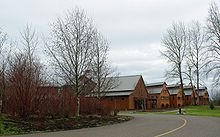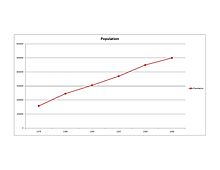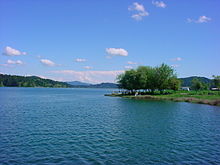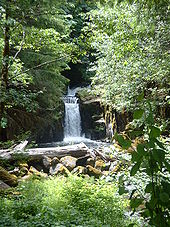- Clean Water Services
-
Clean Water Services 
Type Public utility Genre Wastewater treatment Founded 1970 Headquarters Hillsboro, Oregon, United States Area served Washington County Website cleanwaterservices.org Clean Water Services is the water resource management utility for more than 500,000 residents in urban Washington County, Oregon and small portions of Multnomah County, Oregon and Clackamas County, Oregon, in the United States. Clean Water Services operates four wastewater treatment facilities, constructs and maintains flood management and water quality projects, and manages flow into the Tualatin River to improve water quality and protect fish habitat.[1] They are headquartered in Hillsboro.[2]
Contents
History
In 1969, Oregon’s Department of Environmental Quality placed a temporary halt to new construction in Washington County.[3] On February 3, 1970, ten cities and sixteen sanitary districts combined to form the Unified Sewerage Agency (USA).[3] Later that year voters in the new district approved a $36 million bond measure to consolidate, construct and upgrade USA's regional public wastewater treatment facilities.[4] The Durham Wastewater Treatment Facility opened in 1976, which replaced 14 smaller treatment plants.[4] Two years later six more treatment plants were replaced with the opening of the Rock Creek Wastewater Treatment Facility.
As population continued to grow in the service area of USA, the water quality of the Tualatin River worsened. In 1986, the Northwest Environmental Defense Center filed a lawsuit against the United States Environmental Protection Agency, prompting Total Daily Maximum Loads for the Tualatin River.[5] A Clean Water Act amendment adds regulation of storm-water runoff, and the Rock Creek Facility achieves 99% removal of ammonia nitrogen. In 1988, the Tualatin Valley Water Quality Endowment Fund is established by the Northwest Environmental Defense Center lawsuit.
USA worked to maintain the quality of the Tualatin River by establishing Surface Water Management (SWM) utility for water quality and drainage in 1990, and began a $200 million facility expansion and upgrade program to meet compliance deadlines. That same year, the agency established the River Rangers program. USA begins consumption-based rates and combines billing with water providers in 1994.
In July 2001, the United Sewerage Agency renamed itself as Clean Water Service at a cost of $60,000.[6] Clean Water Service's Operations Building opened in 2003, which is used as a showcase of low impact development and the Administrative Building Complex opens. It is the first LEED Gold certified public building in Washington County. In 2004, the agency began a program to add shade along the watersheds streams and river by planting trees and shrubs to lower temperatures of the waterways.[7][8] This program received approval from environmental regulators and was in lieu of spending $150 million to build chilling systems at the four treatment facilities.[7]
The agency's Rock Creek facility won an EPA National Clean Water Act Recognition Award in 2006,[9] and in 2008 the Durham facility's Influent Pump Station is the first to earn LEED Silver certification.[10] The following year the Durham plant becomes the United States' first wastewater treatment plant to produce commercial fertilizer.[11] In 2010, the Clean Water Institute was established by the agency.[12]
Services
Clean Water Services provides stormwater and wastewater services in partnership with 12 member cities that include; Beaverton, Tigard, Tualatin, Hillsboro, King City, Forest Grove, Sherwood, Cornelius, Banks, Gaston, Durham, and North Plains.
Clean Water Services is a special service district that serves as a separately managed and financed public utility. The Washington County Commissioners serve as the board of directors for Clean Water Services.[3]
As a wastewater utility, Clean Water Services cleans more than 60 million US gallons (230,000 m3) of wastewater a day. The watewater treatment process uses physical, biological, and chemical treatment to clean wastewater to some of the highest standards in the nation. The cleaned wastewater is then released into the Tualatin River.[13] The wastewater is collected by a vast network of more than 800 miles (1,300 km) of sewer lines and 39 pump stations and routed to one of four treatment plants—Durham, Rock Creek, Hillsboro and Forest Grove.
Ten percent of the wastewater treated by Clean Water Services is used for irrigation and in area wetlands during the summer months.[14] Biosolids recovered through the treatment process are sold to farmers in the region as fertilizer.[2] Additionally, the Durham Advanced Wastewater Treatment Facility is the first in the nation to recover fertilizer from a natural byproduct of wastewater treatment.[15] In 2007 the Durham facility began working with Ostara Nutrient Recovery Technologies to construct a $2.5 million multi-reactor plant [16] that allows the Durham facility to run part of its waste stream through special reactors that transform potentially damaging nutrients into environmentally friendly fertilizer, which Ostara sells commercially.[17]
As a surface water management utility, The District’s Stormwater Management (SWM) program improves water quality, protects fish habitat and manages drainage by operating and maintaining the stormwater conveyance system, establishing design and construction standards, regulating activities that can impact the watershed and enhancing streams and floodplains. Clean Water Services is the regional SWM utility for urban Washington County. In cooperation with Washington County and the 12 member cities Clean Water Services maintains and enhances the public drainage system to meet public needs and to comply with strict water quality regulations set for the Tualatin River drainage area by the Oregon Department of Environmental Quality (DEQ).[13]
Clean Water Services offers a classroom educational program called River Rangers geared toward 4th-grade students.[18] Environmental educators interactively teach students about the water cycle, watersheds, surface water pollution, water conservation and wastewater treament. The 45-minute presentation is used to educate students about how people impact water quality through use of sewer and storm systems.
Tualatin River
The 80-mile (130 km)-long Tualatin River meanders slowly through relatively flat terrain, draining more than 700 square miles (1,800 km2) of forested, agricultural and urban areas before joining the Willamette River.[19] The Tualatin is Washington County's only river, and it is used for the regional drinking water supply, agricultural irrigation, and recreational activities. Clean Water Services has worked to protect the health of the watershed through programs such as the planting of trees and shrubs along the water corridors.[19]
Water supply
As communities in the Tualatin Basin continue to grow, more water will be needed for municipal and industrial uses.[20] In addition, more water is needed to augment flow in the Tualatin River and its tributaries for water quality.[21] The two water supply options being considered assume aggressive conservation targets for homes and businesses, wastewater reuse, and aquifer storage and recovery.
- A 40-foot (12 m) dam raise at Henry Hagg Lake with a raw water pipeline pumpback.
- A multiple source option that includes a 25-foot (7.6 m) dam raise at Hagg Lake with a raw water pipeline pumpback and expansion of the Willamette River Water Treatment Plant for municipal uses.
References
- ^ Haight, Abby. Stream to get healthy helping of native plants. The Oregonian, November 29, 2007.
- ^ a b Much, Justin. Farmers and neighbors debate use of biosolids. Statesman Journal, November 7, 2007.
- ^ a b c Tsao, Emily. Skate park search uncovers plans for sewage ponds. The Oregonian, October 24, 2007.
- ^ a b CWS' Durham facility celebrates 30 years of treatment operation. The Tualatin Times, December 28, 2006
- ^ Oregon Water Science Center Active Projects
- ^ Highlights, lowlights and other dubious achievements of the year 2001. The Oregonian, December 27, 2001.
- ^ a b Arrandale, Tom. Trading for clean water. Governing Magazine, April 2004. Pg. 32.
- ^ Delegation secures $640,000 for water supply project and title transfer process. Beaverton Valley Times January 3, 2008.
- ^ County treatment site wins honors. Forest Grove News Times March 14, 2007
- ^ LEEDing the Way. Treatment Plant Operator Magazine June 2010
- ^ Ostara Nutrient Rocovery Technologies Inc.: Oregon Wastewater Treatment Plant Is the First in U.S. to Recycle Nutrients Into "Green" Commercial Fertilizer. Wall Street Journal Market Watch September 23, 2008
- ^ County spins off patented science biz. Christian Gaston, Forest Grove News-Times March 4, 2010
- ^ a b Griffin, Jeff. Overcoming pipebursting challenges--on time, under budget; Rehabilitation TECHNOLOGY. Underground Construction, February 1, 2007. Pg. 49(2) Vol. 62 No. 2 ISSN: 1092-8634.
- ^ Mayes, Steve. Two-pipe system with fresh, recycled water taps into future. The Oregonian, August 29, 2005.
- ^ Smith, Kennedy. Tigard treatment plant turns waste into fertilizer. Daily Journal of Commerce, June 1, 2007.
- ^ Smith, Jill Rehkopf. Kennedy lauds sewage plant's green setup. "The Oregonian", June 11, 2009.
- ^ Renfroe, Don. Clean Water Services to extract nutrients from waste for fertilizer. "The Oregonian", November 13, 2008.
- ^ Sherman, Barbara. Durham students learn how to protect Tualatin Watershed. Tualatin Times, December, 5 2005.
- ^ a b Gorman, Kathleen. Tualatin River treated with tradeoff. The Oregonian, October 12, 2007.
- ^ a b Gorman, Kathy. Washington County: Water partners wonder how to increase supply. The Oregonian, June 7, 2007.
- ^ Colby, Richard. Hagg Lake water helps river run. The Oregonian, July 1, 2004.
- ^ Carr, Housley. Population Growth Drives Rising Tide Of Water and Wastewater Projects; Utility owners look to alternative supply methods in some regions. Engineering News-Record, November 27, 2006. SourceBook: Water/Wastewater; Pg. 44 Vol. 257 No. 21.
External links
 Media related to Clean Water Services at Wikimedia Commons
Media related to Clean Water Services at Wikimedia Commons- Washington County Commissioners
- Tualatin Basin Water Supply
- Tualatin River Watershed Council
- Tualatin Times
- Oregon Water Science Center Active Projects Tualatin River Basin Water Quality Assessment
Coordinates: 45°30′06″N 122°59′23″W / 45.501625°N 122.989712°W
Categories:- Water management authorities in the United States
- Multnomah County, Oregon
- Washington County, Oregon
- Clackamas County, Oregon
- Hillsboro, Oregon
- Sewage treatment plants in the United States
- Local government in Oregon
Wikimedia Foundation. 2010.




